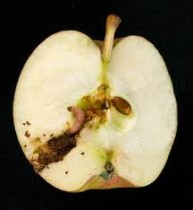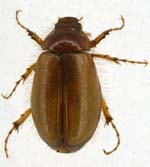Wally Richards – seasonal pests
There are two seasonal pests that are going to emerge over the next few weeks: the Codlin Moth and the Grass Grub Beetle.
When these adult pests actually emerge will depend on the weather and warmth, with November and December being the normal months of activity.

Codlin moth damage
The codlin moth emerges after apples, pears and walnut fruit have set on the trees. They come out from their cocoons and becoming active at dusk, when temperatures are over 15 degrees. They mate and the female lays eggs (up to 300) on the foliage of the host trees. The eggs hatch after 10-14 days and head for the nearest young fruit, where they eat a hole and tunnel into the centre, doing the damage they are well known for.
The first method to control these pests is to to obtain a codlin moth pheromone trap that lures the male moths to its sticky pad (many garden centres stock the traps). The traps themselves are likely to reduce the instance of damage if set up about now. If in a perfect world, you were to catch all the male moths before they had a chance to mate, then the females would lay only infertile eggs. But as we see, only one female needs to mate to ruin up to 300 fruit! So the trap is not a perfect control but it is a fantastic monitor.
A tin of treacle hanging in an onion bag will also work as a trap for the male moths. By checking the trap every couple of days one can determine when the moths are active and then start spraying about 7 days later. Neem Tree Oil sprayed about every 7-10 days to cover the young fruit will help to reduce damage. Spraying starts 7 days after an influx of males is noted in the trap. (If you are not using a trap, start spraying once the temperatures are about 15 degrees). Spray late in the day when the sun is off the trees and repeat every 7-10 days. Add Raingard to the spray to prevent it washing off in rain and to give additional UV protection. MBL can be added too. If totally successful one should only find a pin prick scar on fruit at maturity where the grub took its first and only bite.
If you have an apple, pear or walnut tree that has not had the problem in the past, then don’t worry about any controls. If the problem develops in time to come, then you can do the above.

Grass Grub Beetle
Next, our arch enemy the Grass Grub Beetle. These beetles emerge from October through to December in most parts of the country. Two signs can be observed to determine their activity: 1) you will notice the foliage of a number of plants such as roses, beans and citrus being eaten but no pest present (holes are noted during the day when the beetles are away resting); 2) you will hear after dusk, the thump of the beetles hitting un-curtained windows of rooms, with lights on. The more beetles you can kill, the less damage to lawn grasses and the roots of other plants will be done. Each female can lay up to 40 eggs.
Knowing that the beetles are attracted to light makes them an easy target for control. Secure a wall-paper trough (or similar) right under a window pane, fill two thirds with water and float a small amount of kerosene on to the water. Turn a strong light on in this window prior to dusk and leave until activity has stopped for the night. The beetles will fly to the light, hit the window, fall down into the trough and not be able to get out because of the floating kerosene. Do this to one or more windows, facing each lawn area. Your competition will be any other lights, which if under your control should be turned off (especially outside lights). Pull curtains on other windows.
Street Lights will reduce the effectiveness of this method in the front of your home. Lawn areas near street lights are always the worst effected by the grass grubs. You don’t want a lot of holes in your rose’s leaves and other plants so you will need to spray their foliage with Neem Tree Oil and Raingard mixed, about every 10-14 days. You spray the leaves, a beetle comes along that night, takes a munch on the leaf and stops eating. The beetle then starves to death. This can also be an effective control in reducing the number of grubs that are going to eat your lawn’s grasses. So watch closely for plants that have holes in their leaves and no sign of a culprit. Soon as noticed, start spraying. The female beetles who mate and lay eggs, lay the eggs 70 to 200mm deep in the lawn. The larvae hatch about 16 to 21 days later and start feeding on the roots at that depth. Far too deep to have any effect from chemical or natural controls so don’t waste your time and money trying to kill the grubs till next autumn when they have eaten their way up nearer to the surface.
You can however do your best to keep the lawn in good health and actively growing by applying adequate moisture, with slow release food such as Bio Boost. De-thatch with Thatch Busta. Do a monthly spray with MBL, Perkfection and Mycorrcin mixed together. Only mow the top third off the grasses, on any one mowing and adjust the mower to mow at a height of about 30 to 50 mm for normal mowing.
Lawns that are growing on heavy soils should be top dressed with Gypsum a couple of times a year and watered in. This breaks up the heavy soils and allows for better root penetration and production. There is nothing nicer than a green carpet of lawn, flowing between paths and gardens.

